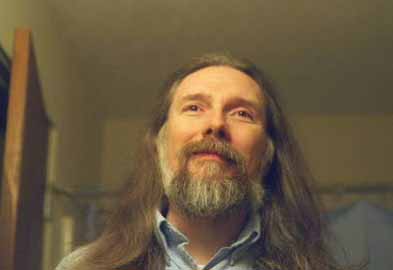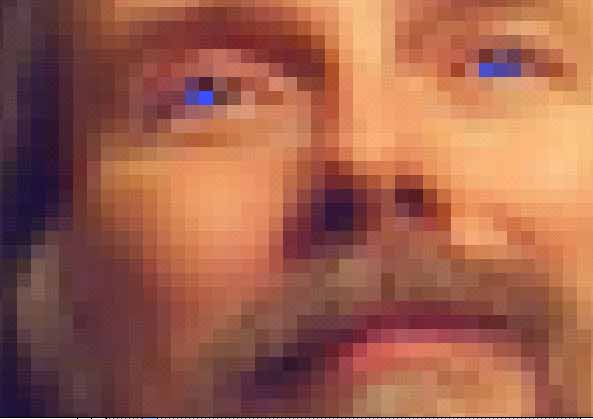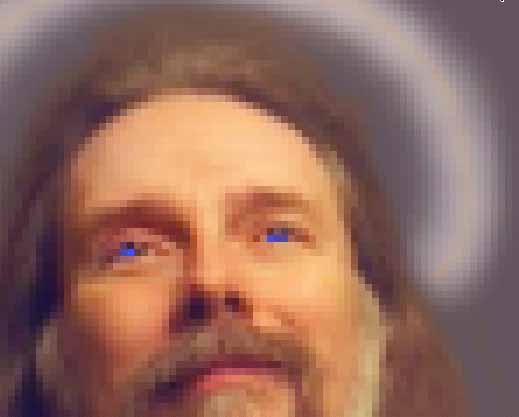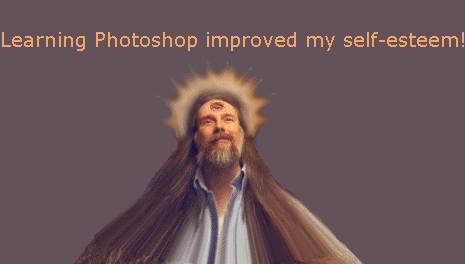- All images on this Web site are Copyright 1998 by Bob Stepno. Please, please do not make a T-shirt or postcard of me embarassing myself or put any of these pictures on YOUR Web page without sending me lots and lots of money. For permission, write to bob@stepno.com
-
Notes:
1. Why are so many words emphasized with bold type on this page? It's partly my response to an experiment in readability, and partly inspired by tabloid gossip columns that highlight celebrity names to keep you reading. If you think the bold words caught your attention and helped you read this quirky essay, or if they were just annoying, click on my name below and send an email telling me about it.
2. Where can I find a serious discussion of image manipulation?
3. Where can I really learn Photoshop? You can go as far away as Australia or Russia, or just to Hanes Hall!
4. How about more inspirational text on telling reality from image or information from disinformation?
Image Hubris
A minor rant on photographic integrity, temptation and ego
by Bob Stepno
Part 1:| What started out as photo-retouching has, at least
since the advent of Photoshop, become a terrible temptation to manipulate
visual reality with computers. Photojournalists who have braved battle
zones and charging rhinos to get pictures of real and decisive
moments are understandably aghast -- how is the public to know that
an image shows an instant of truth? And that it represents a lifetime
of resourcefulness at "getting the shot" and a wealth of talent
at "seeing" with a camera?
With digital photography and photo editing now even available on Nintendo Gameboy systems (starting in the summer of 1998 while Godzilla was lunching at Taco Bell), I think it's almost time for photo-realists to start assuming that the public is so jaded by easily faked images that people need to be beaten over the head with the details. |
Should every "straight" photo in a newspaper have a label like
this?
"This image is exactly what the photographer saw through the lens. No image enhancements have been added. Yes, it's a real rhino. And it charged the camera of its own free will. The photographer is recovering in a hospital in Kenya..." Meanwhile, people have to be warned that digital photo-editing itself is a slippery slope, an evil technological temptation. They may be flirting with unnatural powers of manipulating reality. (See why I call this a rant?)
|
Part 2:
| As you may have guessed, this Web page is also about having fun with
hyperbolic text, tricking an audience of visually-seduced skimmers
and browsers into reading this stuff, teasing them by burying the hot
images until later so I can warn them about the real danger
lurking in that Photoshop package...
Photoshop abuse may start innocently enough by removing scratches and flyspecks from that scanned picture of Aunt Ida, but next thing you'll be trimming her unsightly moustache and restoring the roses to her cheeks and the sheen to her hair... then you'll be snipping Uncle Ernie out of the picture because, well, nobody in the family wants to be reminded about Uncle Ernie after that incident with... Oh, never mind...
|
This Web page is a bad example. It started out as an innocent
demonstration of a problem with JPEG images...
Well, no. Since we're into honesty in words as well as images, I'll admit that it actually started out as an attempt to finish off the end of a roll of film by shooting a quick picture of myself in the bathroom mirror a couple of months ago, complete with shower curtain in the background. For one thing I wanted a record that, yes, I did go for a couple
of years without a haircut while working on my Ph.D. For another, my
old friend Maier Goldberg said the photo on my
web page resume looked "too much like an old fuddy-duddy." (Not
an exact quote, but you get the idea...)
|
Unfortunately, the angle of the more recent picture made me look pretty foolish, gazing off into space like Willie Nelson playing a character on the X Files expecting a alien visitor. And the bathroom background is about as ugly as you could get, thanks to the 60 full watts of lighting and tastefully sagging shower curtain.

The one thing the picture seemed good for was demonstrating that JPEG problem: how JPEG compression can cause a streaking effect in an area of solid color... Having JPEG as an excuse to inflict this photo on you was appropriate, since a class I'm teaching this summer includes an introduction to photo-scanning and a discussion of GIF and JPEG image formats.
JPEG's compression algorithm is great for pictures with lots of colors, but if you have large areas with one color, like the dull background in my bathroom, JPEG creates a water-damaged-silk or peeling-paint effect, at least on my Macintosh monitor with an old copy of Netscape. (Honest, my bathroom is actually in better shape than this.)
As pictures go, it ain't pretty.
So the first thing I did with Photoshop was to paint out the background and crop the image so it was just me and the equivalent of the Motor Vehicle Department's neutral gray-blue backdrop.
 Since the picture was taken in a mirror, I also flipped it horizontally
so the left side of my face is really on the left. "Flipping" used to be
a common practice, even with news photographs, but nowadays photojournalists
consider it a violation of the integrity of the "real" image, if
not intentionally deceptive. You can even find 19th century engravings
of Abraham Lincoln based on "flipped" photographs that put his famous
mole on the wrong cheek.
Since the picture was taken in a mirror, I also flipped it horizontally
so the left side of my face is really on the left. "Flipping" used to be
a common practice, even with news photographs, but nowadays photojournalists
consider it a violation of the integrity of the "real" image, if
not intentionally deceptive. You can even find 19th century engravings
of Abraham Lincoln based on "flipped" photographs that put his famous
mole on the wrong cheek.
In this case, since the photo originally was literally a mirror image, I felt flipping it back to reality was something I could defend... but the picture was still ugly and dumb.
Next, I filtered the electric-light green out of the image. However, none of that improved the sappy look on my face, with that odd "gazing off into the clouds" expression, but I was having fun with Photoshop...
One thing led to another, and an idea was born: As an excuse for spending all this time playing with Photoshop, this Web page is now an essay on how computer-editing makes it much too easy to change images -- even your self-image. Consider it a hint that visual designers should, at times, question whether this great power is, well, affecting them in some way...
Flipping and color correction are things that photographers have been able to do in the darkroom for years. But these techniques and more, things that used to require at least a steady hand with a retouching brush, are now just a mouse-click away.
Envious of people with those sparkling blue eyes? You could buy contact lenses... or you could just zoom into a Photoshop image until you can "see the whites of their eyes," and in this case use a blue pencil on some of the brown pixels.

Yes, this is the same picture from the bathroom. It also shows the effects of two relatively mundane Photoshop tricks -- since the color picture was taken under indoor lighting, I've corrected the color balance to make the skin tones a more natural.
While trying to paint out the background right up to the edge of my head, the airbrush tool left an accidental "halo" effect. That, along with that skyward gaze, and memories of a friend's trips to India to study with a guru whose hair was almost as long as mine is now, put a strange thought in my head... I also may have been inspired subconsciously by having "Touched by an Angel" on the TV in the background...
Whatever... I was inspired to play with the image a little more,
to see if I could airbrush the haze
around my head and make it look more like a halo. I also played with
the "dodge" and "blur" tools and a hint of gold coloring.
(And OK, the result looked more like a smoke ring than a halo,
but that's part of the point: Photoshop makes it too easy to do
cool stuff. It's easy to let yourself just do it because you can,
not because you have a good reason to do it.


Folks who know me realize I intend no offense to anyone's idol, guru or deity.
Others may just have to take it on faith.